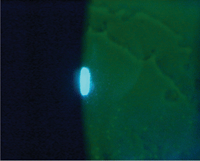 Q: What treatment approaches can you recommend for a diabetic patient with persistent recurrent corneal erosion (RCE)—despite scraping, repeated bandage lenses and stromal puncture?
Q: What treatment approaches can you recommend for a diabetic patient with persistent recurrent corneal erosion (RCE)—despite scraping, repeated bandage lenses and stromal puncture?
A: Because their corneas heal more slowly and sometimes in an aberrant fashion, patients with diabetes are more prone to RCE and other complications. RCE is thought to be more common among people with diabetes due to deposition of advanced glycation end products (AGEs), a kind of “glucose cement” on the hemidesmosomes that anchor the basal corneal epithelium to Bowman’s layer. These deposits make the anchor points less elastic, so even minor trauma or rubbing of the eyes can result in epithelial sloughing.
Before initiating any treatment, W. Lee Ball, O.D., associate director of medical affairs at Johnson & Johnson Vision Care Institute, Inc., says it’s best to talk with patients about their level of diabetes control. “Ask them what their glycosylated hemoglobin levels are and when they last had them checked—ideally, they should be as close to 6.5% as possible without causing episodes of hypoglycemia,” he says. “Wound healing is slow to begin with in patients with diabetes, but that’s exacerbated significantly when it’s not well controlled, so you want to address that first.” Dr. Ball also stresses the importance of pinpointing what caused the original insult to exclude the possibility of an underlying epithelium basement membrane disease.

Presentation of reccurent corneal erosion.
A. Paul Chous, M.A., O.D., also believes diabetes control should be top priority. “My first strategy is to reduce blood glucose levels to limit further AGE formation (HbA1c target < 7% or at least 10% lower than current level),” says Dr. Chous, who practices in Tacoma, Wash., where he specializes in diabetes eye care and education. “I would also add an AGE inhibitor like benfotiamine, a lipophilic analog of vitamin B1 that has been shown to reduce AGEs in animals and humans with diabetes.” He recommends 250mg of benfotiamine b.i.d. with meals.
“Because AGEs are metabolized at a very slow pace, I would continue this regimen for six months in recalcitrant cases, backing off on the doxycycline and steroid once recurrences are stabilized,” he says. You’ll want to follow up weekly to bi-monthly, performing a visual inspection with fluorescein or lissamine green to get an overall idea of the progress the cornea is making, until re-epithelialization occurs.
“Once you’ve gotten the epithelium to lay down, cyclosporine (Restasis, Allergan) can be very useful in slowing down the inflammatory cascade and has the additional benefit of getting the eye to produce more of its own tears,” Dr. Ball says. “However, that takes time to work so it’s more of a long-term solution after you’ve gotten the eye to re-epithelialize, in order to mitigate or prevent future corneal erosions.”
If all else fails, you might want to refer the patient to a corneal specialist for consideration of alcohol debridement or excimer laser phototherapeutic keratectomy.
1. Wang L, Tsang H, Coroneo M. Treatment of recurrent corneal erosion syndrome using the combination of oral doxycycline and topical corticosteroid. Clin Experiment Ophthalmol. 2008 Jan-Feb;36(1):8-12.

